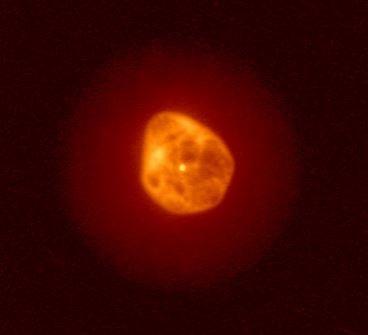
Puzzling Microsoft Worldwide Telescope Anomaly
A Dark Star-related puzzle: I've been sent a short video clip by a correspondent named David Gittins. He has discovered an unusual anomaly on the Microsoft Worldwide Telescope program. It appears to show a glowing red planet - a possible sub-brown dwarf, or something else entirely?
https://www.youtube.com/watch?v=bagwwr4P8AA
(NB the video is no longer available publicly on
YouTube)
Some people comment that it might be a supernova, which it may well be, but it's
strange then that it hasn't been labelled. It may be an anomalous artifact left
over from when the images was taken. I find it puzzling. I've been sent
some interesting links of similar looking celestial phenomena by my
astrophysicist friend. A word to the wise, Nibiru-hunters - it's worth
taking a look at these possibilities when considering a candidate object for
Nibiru on these astronomy databases:

"The shaping of planetary nebulae is a complex process affected by the action of fast stellar wind and collimated outflows. The same mechanisms are responsible of the production of hot gas in planetary nebulae: In the standard interacting-stellar-winds model of planetary nebula formation, the fast stellar wind, escaping from the central star at velocities 1,000-4,000 km s−1, sweeps up the slow AGB [Asymptotic Giant Branch] wind to form the sharp nebular rims and shells typically seen in planetary nebulae".
"Formation of a Planetary Nebula" with thanks to
Mattia
iaa.csic.es_article
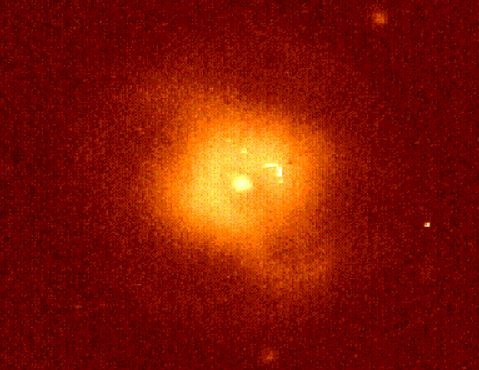
Image Credit: Bill Keel
"Glowing in the red light emitted by hydrogen atoms,
the planetary nebula NGC 4361 is pictured above. The nebula itself is formed by
the outer layers of gas shrugged off by the central star visible in the image.
The curved tendrils of emission reaching out from the body of the nebula have a
shape reminiscent of the arms of of a spiral galaxy."
"NGC 4361: Galaxy Shaped Planetary Nebula" 28 December 1995, with thanks to
Mattia
Then there are those more familiar fuzzy objects, comets:
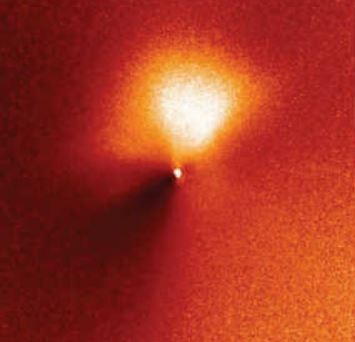
Image Credit: NASA/HST
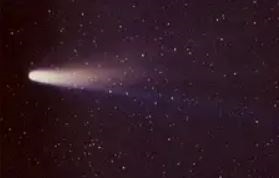
Astronomy Cast "Comets, Our Icy Friends from the Outer Solar System" 13 January 2007
The anomalous object is in Gemini, at R.A 06h 08m, Dec. +22˚47'. Compare this location with the coordinates for the open star cluster M35 at R.A 06h 09m Dec.+24˚20':
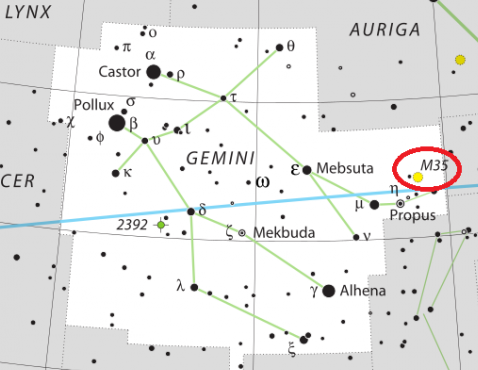
The location of Messier 35 in the norther n Gemini constellation.
Image credit: IAU/Sky & Telescope magazine/Roger Sinnott & Rick Fienberg
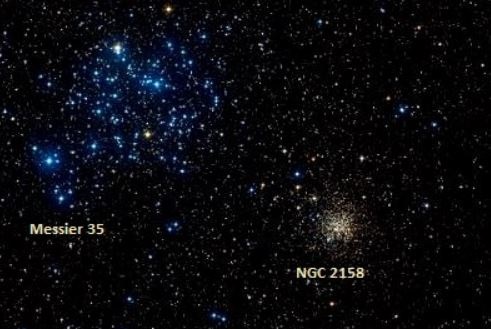
"Messier 35 is 2,800 light years away from Earth and is relatively young as star clusters go, having formed only about 100 million years ago. The cluster occupies a region of space that is roughly 24 light years in diameter, and an area of 28 arc minutes on the sky – which is roughly equal to the size of the full Moon."
"Messier 35 – the NGC 2168 Open Star Cluster"
They're certainly close, but the star cluster is not a red object like the one seen on the Microsoft Worldwide Telescope program.
Here are IRAS infra-red images of the location described in the video. The first is a wide view of the area, and the second if a close-up of the left-hand part of the image. You can click on them to go the NASA pages for further data:
Further research by Mattia through the astronomy databases has brought up the following image taken in the vicinity of this anomaly, but not at the exact coordinates. He found it at sky-map.org and it originally comes from the U.S. Naval Observatory (catalogue reference USNO-A2.0=1125-03465140). It does not appear on inspection of DSS (visual) and IRAS infra-red images.
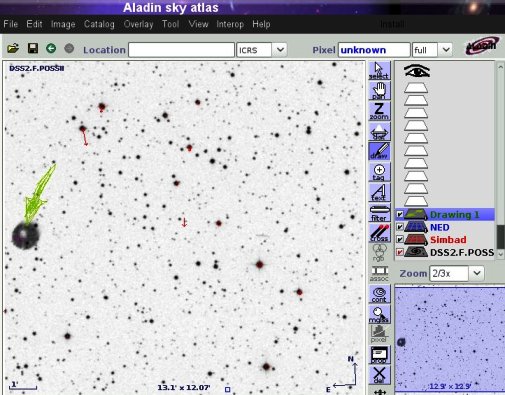
The coordinates of the object are Ra 06h 08' 53.162" Dec. +22 46 50.77 (Right ascension (FK5) Equinox=J2000. (computed by VizieR, not part of the original data)). The magnitudes of the object are Magnitude (blue)=16.1 Magnitude (red)=14.9.
Here are some technical notes about the U.S. Naval Observatory images:
(Note: USNO-A2.0 contains 526,280,881 sources, and is based on a re-reduction of the Precision Measuring Machine (PMM) scans from POSS-I O and E plates (>=-18°) and SRC-J and ESO-R plates (<=-20°). USNO-A2.0 was created by Dave Monet and collaborators at Flagstaff Station, U.S. Naval Observatory.
The major difference between USNO-A2.0 and its previous
version
USNO-A1.0 is that A1.0 used the
Guide Star Catalog as its reference frame whereas A2.0
uses the ICRF as realized by the
USNO ACT catalog (Urban et al. 1997). The VizieR
search engine uses an
on-line compressed version (3.6Gbytes) which was
generated at CDS.)
So, getting beyond the technical material, let's consider the possibilities. An anomalous object has been spotted on the Microsoft Worldwide Telescope image database. However, it is not seen on other astronomical databases commonly available. Close to this anomaly, Mattia has found a similar looking object, also not described in the literature, on the U.S. Naval Observatory database. If it is the same, then it has moved between the times that each image was taken.
The fact that it has moved is quite interesting in itself. It implies that it is a solar system object, rather than a deep space object. Mattia has done a quick back-of-an-envelope calculation and thinks that, if they're the same object, it would be located beyond the Kuiper Belt.
Andy Lloyd, 6 August 2010 and updated 6 January 2022
author of 'The Dark Star' (2005), 'Ezekiel One' (2009), 'The Followers of Horus' (2010), 'Darker Stars' (2019)